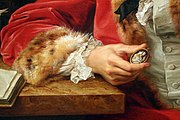Cuff (outerwear)
Cuff ( French manchette 'little sleeve'; derived from the Latin manus 'hand') refers to the bottom end of the sleeve, which is usually on the hand and around the wrist , especially on a shirt or blouse . There were and are different forms of the cuff.
The cuff was and is often a kind of counterpart to the collar . They often complement each other in style and form or have a certain relationship to one another.
Historical
Cuffs that stand out from the actual sleeve have been around since the Renaissance or since the 16th century. The word itself was adopted from French into German at the end of the 17th century, and at that time referred to the ruffles of the shirt that fell from the sleeve of the Justaucorps (baroque frock coat for men) over the hand. In Germany they were also called "hand frills" or "hand sheets".

Already in the Spanish fashion (approx. 1550 - 1630) of the Counter Reformation , the then modern ruff often corresponded to similar ruffles on the wrist, both were often decorated with lace . In addition, smooth and starched cuffs emerged as cuffs, which were thrown over the sleeves of the doublet or dress and were often decorated with lace.
These lace cuffs had their counterpart in the similarly designed, typically early baroque lace collar, as it was known since the end of the 1580s. The types of cuffs described were common for both women and men. In the early baroque era, however, the sleeves of women's clothing gradually became shorter and shorter, and the cuff also slid further up, away from the wrist.
From around 1650, at the court of Louis XIV of France, the baroque lace cuffs developed as described above. The lace ruffles on the sleeves of women's dresses were (still) called cuffs, although in the 17th and 18th centuries the sleeves of women only reached to the elbow, and the lace cuff of the shirt thus only fell over the forearm.

In the 18th century and around 1800 there were special cuffs for mourning, which were called “ pleureuses ” (French: weepy, wailing woman) or “frisettes”.
Since the Biedermeier period (approx. 1815–1850), the cuff, especially in men's clothing, has roughly assumed its modern form, which is still relevant today (as of 2018; see below).
Since the cuff is particularly threatened by soiling, replaceable starched cuffs ("rolls") came into fashion at the end of the 19th century, which, as an independent item of clothing, could be slipped over the wrist into the skirt sleeve, similar to the interchangeable shirt . They were buttoned using cufflinks but went out of style after a few decades.
The modern cuff
Today, a cuff is understood as a permanently attached sleeve end that can be closed with a button and buttonhole or with a cuff link, worked as a cuff or cuff. It is often slightly stiffened like a shirt collar on shirts , blouses and shirt-like jackets.
A distinction is made between the following types:
- Sports cuff (also Italian cuff): A buttoned cuff without a flap, the buttonable parts of which are placed on top of each other.
- Combination cuff (also known as the Vienna cuff): A simple cuff with a button and buttonhole. However, there is another buttonhole next to the button so that it can also be closed with a cufflink. Because of the lower risk of abrasion, it is often used for fabrics with a synthetic resin - easy care finish . For tailcoat only shirts are worn with combination sleeve.
- Cuff (also Umlegemanschette, French cuff or double cuff): it consists of a double layer of fabric which is folded back to the wrist and is often closed with a cufflink. Shirts for Smoking are usually worn in this form.
- Cuff shapes
The fabric ends of the cuff can be square or (less often) rounded. The sleeves of the shirt should reach the back of the hand. The shirt sleeves and the sleeves of the jacket worn over them should ideally be cut so that the shirt cuff protrudes about one to one and a half centimeters from the jacket sleeve.
Depending on the fashion, in addition to shirts and blouses, women's coats and jackets in particular are fitted with cuffs. Furs, in particular, often have decorative sleeve ends, and winter clothing can also be provided with fur cuffs. If they are not pinned, they allow the wearer to adjust the sleeve length according to the undergarment.
Web links
supporting documents
- ↑ a b c d e f g h Ludmila Kybalová, Olga Herbenová, Milena Lamarová: The great image lexicon of fashion - from antiquity to the present , translated by Joachim Wachtel, Bertelsmann, 1967/1977: p. 435.
- ↑ Ludmila Kybalová, Olga Herbenová, Milena Lamarová: The large image lexicon of fashion - From antiquity to the present , ..., Bertelsmann, 1967/1977: p. 434ff (Fig. 731–733).
- ↑ Ludmila Kybalová, Olga Herbenová, Milena Lamarová: The large image lexicon of fashion - From antiquity to the present , ..., Bertelsmann, 1967/1977: p. 163, 164, 165ff, 436f (Fig. 732).
- ↑ a b c Alfons Hofer: Textile and Model Lexicon . 7th edition, Volume 2, Deutscher Fachverlag, Frankfurt am Main 1997, keywords “Cuff”, “Sport Cuff”, “Wiener Cuff”. ISBN 3-87150-518-8 .




